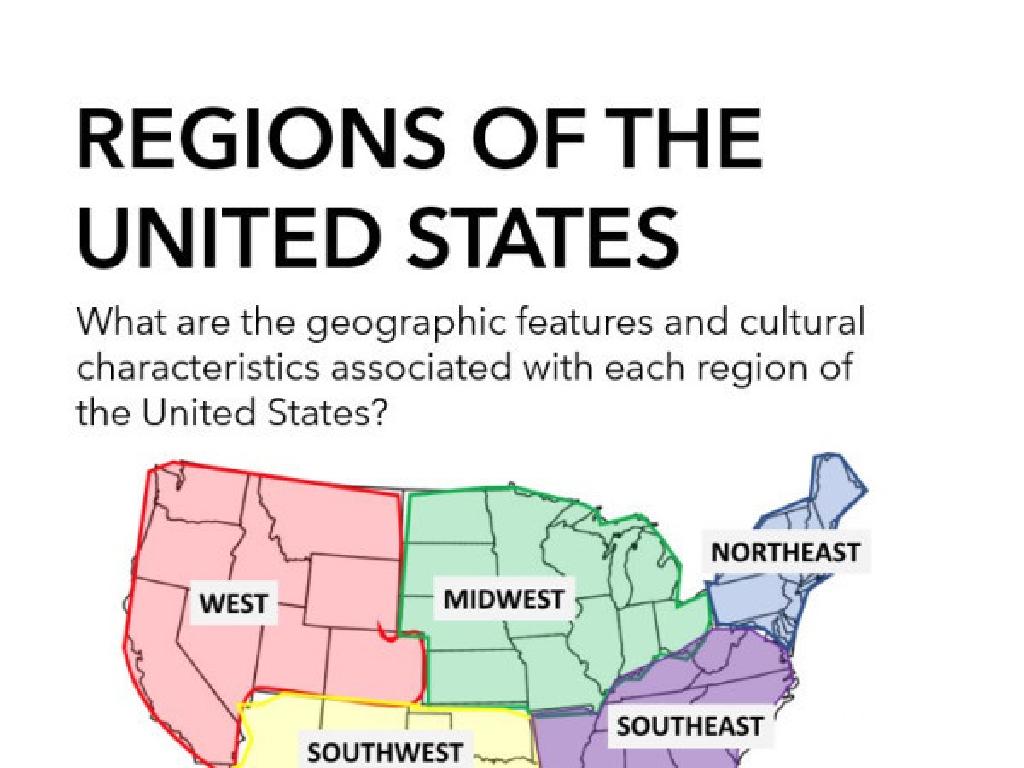How Do Animals Use Their Body Parts?
Subject: Science
Grade: Kindergarten
Topic: Animals
Please LOG IN to download the presentation. Access is available to registered users only.
View More Content
Welcome to the Animal Kingdom!
– Today’s topic: Animals!
– How animals use body parts
– Animals use body parts to eat, move, and protect themselves
– Naming animals and body parts
– Example: Elephants use their trunks to drink water
– Fun facts about animal features
– Did you know? Kangaroos use their strong legs to hop!
|
This slide introduces kindergarteners to the diverse world of animals and their unique body parts. Start by engaging the students with the broad topic of animals, then narrow down to the specific ways animals use their various body parts for daily activities. Encourage the children to think of animals they are familiar with and discuss the different body parts they know. For instance, talk about how birds use their wings to fly or how fish use fins to swim. Share fun facts to make the learning experience enjoyable. The goal is to spark curiosity and encourage participation by asking them to name animals and their body parts. This will set the stage for more detailed discussions and activities related to animal adaptations and functions of body parts.
Animal Movements
– Animals move in many ways
– Birds fly with their wings
– Like eagles soaring high or parrots flapping
– Fish swim using their fins
– Picture a goldfish or a shark in the water
– Let’s move like animals!
– We can hop like a bunny or crawl like a caterpillar
|
This slide introduces the concept of animal movement to Kindergarten students. Start by explaining that different animals have different body parts that help them move in unique ways. Use the examples of birds and fish to illustrate how wings and fins aid in movement. Encourage the children to think of their favorite animals and how they move. The class activity will involve the students acting out the movements of their chosen animals, which will help them connect the concept of animal body parts to their functions. This kinesthetic activity supports learning through action and is appropriate for their developmental stage. Make sure to supervise the activity to ensure safety and participation from all students.
Eating Habits of Animals
– Animals eat using body parts
– Giraffes use long necks for leaves
– Giraffes have long necks to reach high leaves on trees
– Different animals, different ways to eat
– Let’s think about other animals
– Can you guess how a rabbit or a bird eats?
|
This slide introduces the concept of how animals use their body parts to eat, which is a fundamental aspect of their survival. Start by explaining that just like humans use their hands and mouth to eat, animals also have special body parts to help them. Use the giraffe as a clear example, describing how its long neck is an adaptation for reaching leaves high up in trees. Encourage the children to think about other animals they know and how these animals might use their body parts to eat. For instance, a rabbit uses its strong teeth to nibble on carrots, and a bird uses its beak to pick up seeds. This will help them understand the relationship between an animal’s body parts and its eating habits. The discussion can be interactive, with the children sharing their thoughts and observations.
Sensing the World with Animal Body Parts
– Animals sense their world
– Animals use body parts like eyes, ears, and noses to feel around them.
– Dogs use noses to smell
– A dog’s nose is very powerful and helps it to find food and sense danger.
– We have senses too
– How do we use our senses?
– Think about how we use our eyes to see, ears to hear, and hands to touch.
|
This slide introduces the concept of senses and how animals use their body parts to interact with the world. Emphasize that just like humans, animals have senses that help them survive. For example, a dog’s sense of smell is much stronger than ours, and it uses its nose to understand its environment. Encourage the children to think about their own senses and how they use them every day. Ask them to share examples of how they use their sight, hearing, touch, taste, and smell. This will help them relate to the topic and understand how animals use their senses similarly to humans.
Staying Safe: Animal Defenses
– Animals use parts to stay safe
– Turtles hide in shells when scared
– Like a home, a shell is a turtle’s safe place
– Animals have unique protections
– Porcupines have quills, skunks spray a smell
– Think of animals with defenses
|
This slide introduces the concept of animal defense mechanisms to Kindergarten students. It’s important to convey that animals, much like humans, have ways to protect themselves from danger. The turtle is a relatable example, using its shell as a shield. Encourage the children to think of other animals and their unique ways of staying safe, such as porcupines using their quills or skunks spraying a scent. This will help them understand the diversity of animal adaptations and prompt them to think about the function of different body parts. During the presentation, ask the students to share their ideas and discuss why these adaptations are important for the animals’ survival.
Fun Facts About Animal Body Parts
– Animals have special body parts
– Elephants use trunks to drink
– Like a long nose, the trunk is for drinking and lifting
– Unique parts help animals survive
– Each part has a special job, like a monkey’s tail for balance
– Discover more amazing animal parts
|
This slide introduces children to the concept that animals have unique body parts adapted to their needs. Highlight the elephant’s trunk as a versatile tool, used for drinking water and carrying objects. Emphasize that these body parts are not just unique but serve important purposes for survival, such as how a monkey uses its tail for balance. Encourage curiosity by promising to explore more fascinating animal body parts, setting the stage for further learning about the animal kingdom.
Class Activity: Animal Charades
– Let’s play Animal Charades!
– Pretend to be an animal
– Think about how your animal walks or runs
– Show how it moves or eats
– Does it hop, slither, or fly? How does it use its mouth or paws to eat?
– Friends guess the animal
– Can your friends tell which animal you are by your actions?
|
This activity is designed to help students understand how animals use their body parts to move and eat. It encourages them to think creatively and physically embody the characteristics of different animals. Provide examples of animals and their movements or eating habits to inspire them. For instance, a rabbit hops and nibbles on carrots, a snake slithers, and a bird pecks at seeds. Have a space in the classroom where each student can perform while others watch and guess. Possible variations of the activity could include mimicking a cat cleaning itself, a kangaroo jumping, or a butterfly fluttering. Ensure that each child gets a turn and that the guessing is done in a supportive and enthusiastic manner.




/silk_road_trade_routes.jpg)

